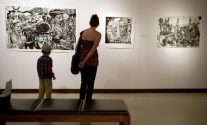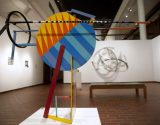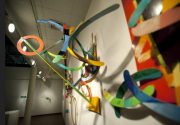By Robin Miller – Arts writer, via theadvocate.com
His mother told him to pass it on.
And he did.
He passed it on to his students who became teachers, and they passed it on to their students.
He passed it on to other artists, who passed it on to their colleagues.
And they’ve gathered in the Louisiana Art & Science Museum on this particular night to share memories of John T. Scott, a friend and mentor who died in 2005 in Houston.
Yet it seemed as if somehow he’s still in the world, even walking with them through the Louisiana Art & Science Museum’s main galleries as Mora Beauchamp-Byrd guided them through Rhythm & Improvisation: John T. Scott & His Enduring Legacy.
That’s the title of the museum’s exhibit of Scott’s work shaped by African, Caribbean and New Orleans musical traditions. The work has been described as “optical jazz” or “visual blues.” The show runs through Sunday, July 14.
But those who knew Scott see this work as something more, something he passed on to them.
“Scott’s said his mother told him that one of the most selfish things you can do on this earth is to give to others,” Ron Bechet said. “It’s selfish, because whatever you give, you’re going to get back tenfold.”
Bechet wasn’t exactly one of Scott’s students. He was studying art at the University of New Orleans at the time Scott was teaching at Xavier University in New Orleans. Bechet was visiting a fellow art student on the Xavier campus when he met Scott.
Scott invited Bechet to his studio to watch a sculpture casting. As was always the case, anyone who visited Scott’s studio became his friend.
And anyone who became his friend remembers first and foremost that Scott always passed it on.
“The more I learn, the more I am obligated to share,” Scott often said. “That idea inspires my art, and also, that’s what teaching has been about for me.”
Scott’s mother was right. Giving is a selfish act. Scott gave and received back in ways that are too many to count.
“It didn’t matter what he was doing,” Martin Payton said.” He was always working on more than one project in his studio. He could be working on a painting and a sculpture and making a sandwich and writing a poem and teaching, and it was all part of the same thing for him. There were no divisions; it was a continuous circle.”
Payton is a professor at Xavier University, where Bechet heads the art department. Payton and Bechet stood in the museum’s main gallery at this moment with Payton’s wife, MaPo Kinnord-Payton, who also teaches art at Xavier.
And they listened as Beauchamp-Byrd presented an art historian’s perspective of her colleague’s work. Yes, Beauchamp-Byrd knew Scott, too.
She’s Xavier’s curator, as well as an art history professor at the school. She didn’t set out to meet Scott with the intention of making her own art, yet she also has been on the receiving end of his “pass it on” philosophy.
She learned from his work, and she teaches her students about it.
And the legacy continues.
Scott was born in 1940 in New Orleans, where he grew up in the Lower Ninth Ward. His mother always reminded him that no matter what he did, he was to do it well.
And Scott listened.
He earned his bachelor’s degree in art from Xavier University, then his master’s degree from Michigan State University, where he studied under Charles Pollock, brother of abstract expressionist painter Jackson Pollock.
Then it was back to New Orleans. It was Scott’s home, and it was where he would spend more than 40 years teaching art at Xavier, where he would marry longtime girlfriend Anna Rita Smith and rear five children.
It also was where he would maintain a studio, a place that Beauchamp-Byrd remembers as constantly filled with working artists, sometimes with 25 people at a time. At midnight.
“I remember going to the studio one night, and they were all working,” Beauchamp-Byrd said. “It was midnight.”
She laughed. It’s a great memory of an artist who didn’t limit himself to one medium. No, it’s more than that. It’s the memory of an artist who didn’t limit himself to any one project at a time.
Scott was always working on various pieces in different mediums, one of which was kinetic sculpture. Many of these pieces are scattered throughout the Louisiana Art & Science Museum’s main gallery on the first floor.
They’re grouped by the series for which they were created, yet it’s as Payton mentioned earlier. These pieces are all a part of Scott’s continuous circle where one thing in life leads to another.
A painting leads to a sculpture, which leads to stopping to make something to eat, which leads to Elizabeth Catlett calling the studio for advice on a piece, which leads to Scott passing it on.
Yes, there was a time when Scott passed it on to the sculptor Elizabeth Catlett. Bechet clearly remembers it.
“I was in the studio when Elizabeth Catlett called,” Bechet said. “She’d watched Scott work, and she wanted to know about a process he’d applied to one of his pieces.”
Catlett died in 2012 a few days shy of her 97th birthday. She was an American-born sculptor and printmaker who lived in Mexico and was known for her black, expressionistic sculptures and prints.
She also had her own New Orleans connection, having once taught at Xavier. She also knew Scott.
And Scott didn’t hesitate to pass it on to her, just as acclaimed sculptor George Rickey passed it on to him in 1983. That’s when Scott received a grant to study kinetic sculpture under Rickey.
“From then on, his artistic output included sculptural works delicately balanced to be in motion,” the museum labels stated. “The new work brought him so much acclaim, and in 1994, he won a prestigious ‘genius’ grant from the John D. and Catherine T. MacArthur Foundation, the only time the award had been bestowed upon a Louisiana artist.”
The grant enabled Scott to purchase a larger studio and complete some grand-scale projects.
“Among his best-known public commissions is ‘Ocean Song’ set in the Woldenburg Riverfront Park and ‘Spiritgates,’ which adorns one side of the New Orleans Museum of Art,” the label states. “That museum later honored him with a retrospective in 2005.”
Then came Hurricane Katrina. Like thousands of New Orleans residents, Scott evacuated his beloved hometown for Houston.
He was 67 when he died while trying to recover from a double lung transplant operation.
“According to his wishes, Scott is buried in New Orleans, the city he loved,” the label states.
But the story doesn’t stop there. It continues with the artists who came together for Beauchamp-Byrd’s program at the LASM.
Their artwork also is part of this exhibit, standing as an example of Scott’s legacy of passing it on.
“I asked these artists to choose the pieces they wanted to show,” Elizabeth Weinstein said.
Weinstein is the museum’s curator; she put this show together. And in doing so, she believed that the artists knew which pieces would best represent Scott’s influence on their work.
This is why MaPo Kinnord-Payton chose a sculpture out of the element of her usual work. It’s a smooth sculpture of a woman’s abdominal section created in Scott’s studio.
Kinnord-Payton met Scott in 1994 while taking part in a conference at the New Orleans Center for Creative Arts. She had taught and produced functional ceramics in Massachusetts and Berkeley, Calif., from 1984 to 1992, then earned her master of fine arts degree from Ohio State University in 1994.
After meeting Scott in 1994, she found herself teaching at Xavier the following year.
“He was like a whirlpool,” Kinnord-Payton said. “He just sucked you in. Then I met Martin, and when Martin and I married, Scott gave me away. He was like a dad to me, and my dad had passed away. Scott told us to ‘pass it on,’ and my dad was a lot like that. And both of them had confidence in my work.”
Kinnord-Payton’s work is joined by that of her husband’s, and, of course, Bechet’s, along with fellow artists Lyndon Barrois, Jeffrey Cook, Albert Cooper, Kimberly Dummons, Augustus Jenkins Jr., Frank Hayden, Steve A. Prince, Scott’s son Ayo Scott and Clifton Webb.
The music continued to play downstairs, both in Scott’s work and over the museum’s sound system. Jazz and blues music often flowed through Scott’s studio while he worked.
His favorite musical artists included Louis Armstrong, John Coltrane, Thelonious Monk, Nora Jones, Wynton and Ellis Marsalis, Ray Charles and Nina Simone. His favorite recording was Miles Davis’ album, Sketches of Spain.
“Scott used the term ‘jazz thinking’ to describe his mindset when creating art; finding inspiration in the improvisatory style of jazz musicians — the way they intuitively selected notes that individually do not make sense but played together constitute a unique and harmonious whole,” the museum label states. “This type of thinking allowed Scott to use space and form to create rhythm and movement.”
In this mindset, Scott’s trademark moving from one artistic medium to another produced bold, colorful artworks that explored such themes as the “diddlie-bow” string instruments from West African culture, the rhythm and movement of early 19th century slave dances in New Orleans’ Congo Square, New Orleans jazz funerals, second-line parades and Louis Armstrong’s legacy.
Now he leaves this legacy, a world of art that continues to inspire Jamieel Paulin, who earned his bachelor’s degree in art this month from Xavier University.
Paulin also attended Beauchamp-Byrd’s program, and he couldn’t hide his amazement of seeing the work by a man he has spent his college years studying. He never met Scott, and he wasn’t required to study Scott’s work. It’s just something he was inspired to do after seeing one of Scott’s works.
“I had to read about him,” Paulin said. “I had to find out everything I could about him.”
Now Paulin was in the museum’s gallery, sharing his story about how his own artwork changed because of Scott’s influence.
And adding to Scott’s legacy by passing it on.
More Information
Rhythm & Improvisation: John T. Scott & His Enduring Legacy
WHAT:A selection of works by late New Orleans artist John T. Scott, as well as works by artists who were influenced by him.
WHEN: Through Sunday, July 14. Hours are 10 a.m.-3 p.m. Tuesday through Friday, 10 a.m.-5 p.m. Saturday and 1 p.m.-4 p.m. Sunday.
WHERE: Louisiana Art & Science Museum, 100 River Road South.
ADMISSION: $7.25, adults; $6.25, children ages 2-12 and seniors age 65 and older; $5, groups of 15 or more. College students with ID and museum members are admitted free.
INFORMATION: Call (225) 344-5272 or visit http://www.lasm.org.




